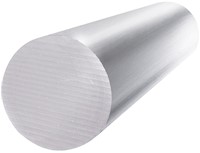| Items |

6061-T6-125
Aluminum Rounds - Series 6061
|

6061-T6-1875
Aluminum Rounds - Series 6061
|

6061-T6-250
Aluminum Rounds - Series 6061
|

6061-T6-3125
Aluminum Rounds - Series 6061
|

6061-T6-375
Aluminum Rounds - Series 6061
|
|
Material
|
N/A
Aluminum
|
|
Shapeform
|
N/A
Round
|
|
Series
|
N/A
6061-T6
|
|
Grade
|
N/A
6061
|
|
Temper
|
N/A
T6
|
|
Diameter
|
N/A
1/8 inches
|
N/A
3/16 inches
|
N/A
1/4 inches
|
N/A
5/16 inches
|
N/A
3/8 inches
|
|
Diameter
|
N/A
0.125 inches3.175 mm
|
N/A
0.1875 inches4.7625 mm
|
N/A
0.25 inches6.35 mm
|
N/A
0.3125 inches7.9375 mm
|
N/A
0.375 inches9.525 mm
|
|
Estimated Weight
|
N/A
0.014 lbs/ft0.020834296 kg/m
|
N/A
0.032 lbs/ft0.047621248 kg/m
|
N/A
0.058 lbs/ft0.086313512 kg/m
|
N/A
0.0900 lbs/ft0.13393476 kg/m
|
N/A
0.130 lbs/ft0.19346132 kg/m
|
|
Estimated Weight per 12' Bar
|
N/A
0.173 lbs0.0784714852 kg
|
N/A
0.390 lbs0.176901036 kg
|
N/A
0.693 lbs0.3143395332 kg
|
N/A
1.082 lbs0.4907869768 kg
|
N/A
1.559 lbs0.7071505516 kg
|
|
ASTM Specification
|
N/A
AMS 4117 AMS-QQ-A-225/8 ASTM B211 UNS A96061
|
|
Ultimate Strength
|
N/A
45 ksi
|
|
Yield Strength
|
N/A
40 ksi
|
|
Elongation percent in 2 inches
|
N/A
17
|
|
Hardness Brinnel Number
|
N/A
95
|
|
Ultimate Shearing Strength
|
N/A
30 ksi
|
|
Fatigue Endurance Limit1
|
N/A
14 ksi
|
|
Modulus of Elasticity2
|
N/A
10.0 x 104 ksi
|
|
Resistance to Corrosion - General3
|
N/A
B
|
|
Stress Corrosion Cracking4
|
N/A
A
|
|
Workability (Cold)5
|
N/A
C
|
|
Mechinability
|
N/A
C
|
|
Brazeability6
|
N/A
A
|
|
Gas Weldability7
|
N/A
A
|
|
Arc Weldability8
|
N/A
A
|
|
Resistance Spot and Seam Weldability9
|
N/A
A
|
|
Applications
|
N/A
Heavy-duty structures requiring good corrosion resistance, truck and marine, railroad cars, furniture, pipelines
|
|
Density
|
N/A
0.098 lbs/in³
|
|
Specific Gravity
|
N/A
2.70
|


